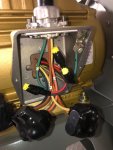Red_Skull
Member
- Location
- Austin, TX
- Occupation
- Electrical Engineer
We've had an air handler VFD (ABB ACH550 with built in bypass) trip on 'Earth Fault' a few times in the past few days. Each time it has run again immediately after being reset and will continue to run for a while before faulting again. This air handler has been running fine for two years without any issues until now.
A single 480V VFD mounted right on the air handler feeds two supply fans in an air handler. Each motor has its own manual motor protector being used as an overload after the drive. Only the drive has tripped; the manual motor protectors have not.
We used a Megger (at 1000V) to test insulation to ground on the motor windings and all conductors from the drive to the motors. Everything came back in the giga-ohm range. Opened everything up and there is no obvious damage anywhere that we can see and grounding on everything on the drive and motors appears to be correct.
All of the wiring is THHN in steel conduit. I saw an older post on this forum that said THHN isn't recommended on drive outputs since the drive output can damage it more easily than other insulation types. If damage is starting to occur, would it not be picked up by the Megger? Is the ground fault measurement by the drive sensitive enough to pick up leakage current that the Megger wouldn't?
I'm out of ideas on this one, and would appreciate any help. Thanks!
A single 480V VFD mounted right on the air handler feeds two supply fans in an air handler. Each motor has its own manual motor protector being used as an overload after the drive. Only the drive has tripped; the manual motor protectors have not.
We used a Megger (at 1000V) to test insulation to ground on the motor windings and all conductors from the drive to the motors. Everything came back in the giga-ohm range. Opened everything up and there is no obvious damage anywhere that we can see and grounding on everything on the drive and motors appears to be correct.
All of the wiring is THHN in steel conduit. I saw an older post on this forum that said THHN isn't recommended on drive outputs since the drive output can damage it more easily than other insulation types. If damage is starting to occur, would it not be picked up by the Megger? Is the ground fault measurement by the drive sensitive enough to pick up leakage current that the Megger wouldn't?
I'm out of ideas on this one, and would appreciate any help. Thanks!



